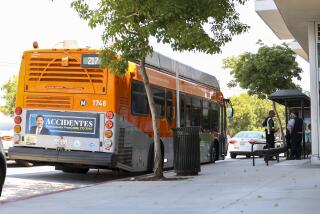Rail alone can’t reinvent L.A.
- Share via
With the Crenshaw/LAX light-rail line groundbreaking last week, Los Angeles now has three rail transit projects under construction — an example of how the city is leading the country in a rail renaissance. The “city that destroyed cities,” as GQ recently described L.A. for pioneering auto-oriented development, has been planning and building a multibillion-dollar rail network, thanks in part to up to $13 billion in local sales tax funds from a successful 2008 measure.
But these billions risk being wasted if city leaders do not promote, and residents do not allow, new growth around rail stations and corridors. Why? Rail is expensive to build, operate and maintain compared with other forms of transit. It only becomes cost-effective with high ridership. And the best way to boost ridership is to locate new jobs, housing and retail near stations.
Focusing development around rail provides multiple benefits. It allows the region to accommodate new residents and natural population growth without building endless subdivisions on open space and worsening traffic and air pollution. It can reduce the high cost of housing by boosting in-town supply, making it easier for businesses to attract and retain talented employees. Finally, rail-accessible development can create convenient, walkable neighborhoods that meet the growing demand among millennials, childless professionals and empty nesters to move “back to the city” — as many recent urban success stories attest.
PHOTOS: Is Gov. Jerry Brown saving California or ruining it?
But the modern history of rail and land development patterns shows that politics and economics conspire to prevent new growth around rail. Decision-makers typically locate rail lines in less dense or developable areas to save costs and accommodate powerful interest groups around the region, running lines through blighted areas or along freeways to save land-acquisition and construction costs and to minimize neighborhood objections.
As a result, many rail station locations, such as on the Blue Line to Long Beach or the Green Line along the Century Freeway, lack opportunities for new development. Creating a market in these areas requires public support to spark demand and lower developer costs. And in rail-rich areas with high demand for housing, such as Hollywood and soon West L.A., well-heeled neighbors can afford to challenge land-use plans and fight new projects, pushing growth into the exurbs and driving up housing costs for everyone.
To reverse these historic trends, Angelenos should insist on three policy changes. First, no dollars should be spent on rail lines or stations without a minimum number of houses or jobs located within walking distance, or at least local plans in place to meet these goals. Second, state and regional governments should provide funding for local plans for rail-oriented growth and help support and maintain the associated infrastructure, such as sidewalks and parks. Finally, state and local governments should help promote well-designed “catalytic” real estate projects in neglected areas to spark revitalization and unlock private investment, such as through revolving loan funds and tax-increment financing.
Los Angeles once inspired the world with a glamorous vision of an auto-oriented life. But with a changing market, growing population, worsening traffic and lost open space, the region has begun to reinvent itself with rail-oriented success stories in downtown Los Angeles, Koreatown and North Hollywood, among others. But these successes shouldn’t mask the missed opportunities and ongoing challenges to maximizing rail investment. Only concerted action will right past wrongs and put the region on a new path to creating livable, convenient and connected neighborhoods around rail.
Ethan N. Elkind researches and writes on environmental law with a joint appointment at the UC Berkeley and UCLA schools of law. He is the author of the new book “Railtown: The Fight for the Los Angeles Metro Rail and the Future of the City.”
More to Read
A cure for the common opinion
Get thought-provoking perspectives with our weekly newsletter.
You may occasionally receive promotional content from the Los Angeles Times.










